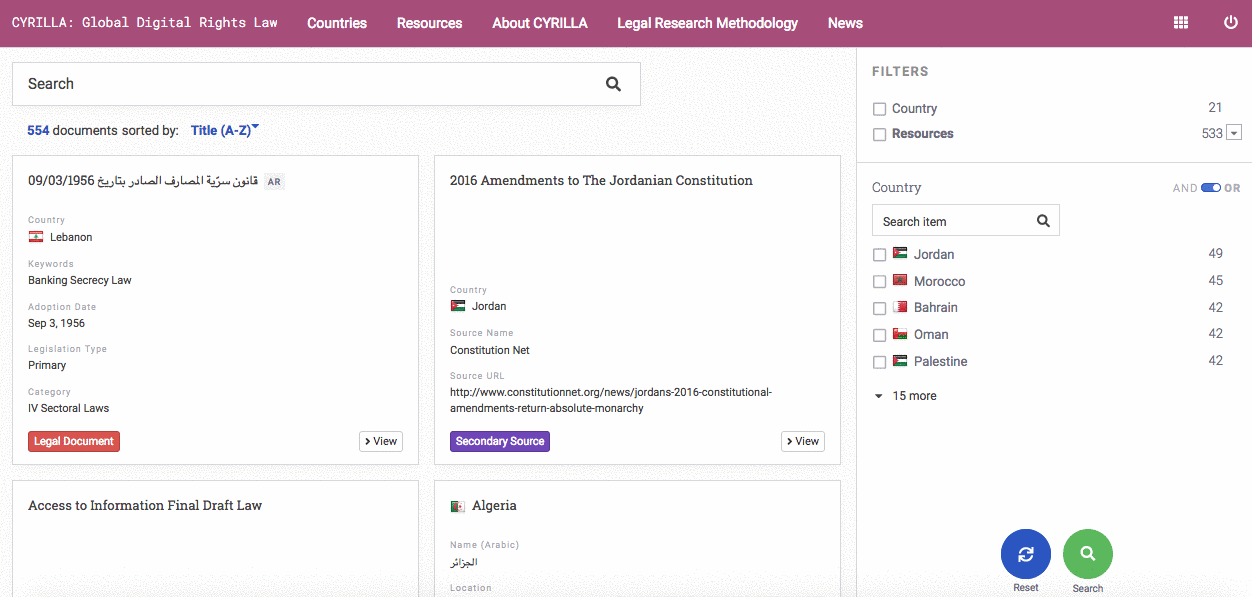When it comes to holding powerful governments accountable for constricting online spaces, knowledge and understanding of legal frameworks in which digital networks operate is crucial. However, the laws that affect human rights in digital environment are widely scattered across legal frameworks. As a result, even lawyers sometimes struggle to understand the effects that specific laws might have on human rights and how they are being used to constrict digital spaces.
SMEX, a Lebanon-based NGO that works to advance self-regulating information societies in the Middle East and North Africa (MENA), believes that everyone from experienced lawyers to law students to activists and NGOs without legal training should be able to make use of law, and that law should be free and accessible to all. This belief is driving the creation of an open online legal data resource called CYRILLA (the Cyberrights Research Initiative and Localized Legal Almanac), which will facilitate and accelerate the sharing, comparison, visualisation, and interoperability of legal information on digital rights.
CYRILLA will offer its users what other legal databases do not offer – the lens of digital rights. SMEX defines “digital rights” as human rights— established by the UDHR, UN resolutions, international conventions, regional charters, domestic law, and human rights case law—as they are invoked in digitally networked spaces. CYRILLA will therefore help filter legislation and case law for provisions and judgements that affect digital rights, or human rights in digital spaces.
Digital rights defined by SMEX:
“Digital rights” describe human rights—established by the UDHR, UN resolutions, international conventions, regional charters, domestic law, and human rights caselaw—as they are invoked in digitally networked spaces. Those spaces may be physically constructed, as in the creation of infrastructure, protocols, and devices. Or, they may be virtually constructed, as in the creation of online identities and communities and other forms of expression, as well as the agency exercised over that expression, for example, management of personally identifiable data, pseudonymity, anonymity, and encryption. Such spaces include but aren’t necessarily limited to the Internet and mobile networks and related devices and practices.
Where CYRILLA takes its roots
The idea for such a resource was born out of the Arab Spring, when citizens, activists and human rights defenders faced extensive human rights abuses, including detention, interrogation and harassment, at the hands of the oppressive regimes they were protesting. The widespread use of national laws as a form of restricting speech and human rights online left many in the region wondering: what were these specific laws that governments applied to digital spaces?
To find an answer to this question, SMEX started collecting national legislation from all the Arab League countries (22 countries) that was specifically affecting digital rights. Having started out with just seven countries and a few units of information in a google spreadsheet, SMEX envisioned a free legal database that would help people understand country-specific legislation better by making laws more visible and legal landscape more tangible.
By researching the laws that affected digital rights more thoroughly, SMEX started mapping the legal frameworks of individual countries and subsequently started to get a more comprehensive picture of the emerging legal framework for online media across the region.
By the end of 2017, SMEX had already developed its own data model and were looking to build a simple platform for the next round of data collection. Not long after, SMEX learnt about Uwazi and decided to explore the potential of this free, open-source tool.
“One of the things that we really like about working with Uwazi is that because it is in an early phase we will be able to have a lot of input into how it develops and really meet some needs of the platform that we are trying to create.”
– Jessica Dheere, SMEX co-founder and executive director
A sneak peek into CYRILLA’s features
During initial stages of collaboration, HURIDOCS and SMEX have explored how Uwazi can be customised to perform a wide range of functionalities intended for the database. Even though this project is still very young, we are already excited about how people will be able to use the database in the future:
- to find same phrases and citations between laws and cases in order to see how one case may be extending to other jurisdictions and how this case becomes influential in the way that digital rights is being conceived;
- to cross reference cases with incident reports and other laws in order to identify specific patterns to help activists and civil society organisations target areas for legal reforms; and
- to scan laws of a certain country when submitting a case to a Special Rapporteur
A more long-term goal for this database is to be able to look at gathered legislation as data, which would allow users to cross reference it with other data sets such as incident reports or jurisprudence, judgements and media reports in order to identify patterns and conduct comparative analysis from country to country.
SMEX envisions CYRILLA to be the first place where journalists, legal researchers, lawyers, human rights defenders, policy makers, NGOs, activists or ordinary citizens can go to orient themselves to what is happening to free expression in a certain place and/or across the region, and to identify areas of inquiry, research, as well as potential opportunities for advocacy.
We are honored and excited to be SMEX’s partner in creating CYRILLA. Check out the CYRILLA site to see our progress!
